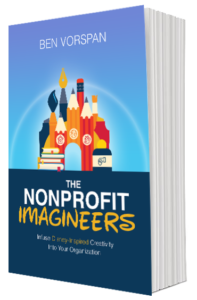
People misuse the word “innovation.” They love to claim that everything is an “innovation…” The synagogue holding services outside rather than inside, after seeing other synagogues do the same thing, boasts their innovation. The launch of a new website sounds like an exciting innovation, until you realize they purchased the same $49 template as thousands of others. The cup holder in your new car that fits an even-more-obnoxiously-large drink is the car-maker’s latest brilliant innovation, and, of course, is worthy of a three-week marking campaign with an ad buy exceeding your non-profit’s annual budget. Wow! Our world is brimming with innovations left and right!
“Innovation” is everyone’s favorite descriptor, even though it’s literally never true. Yes – literally.
New, creative, original, cutting-edge, and clever are NOT synonyms for an innovation.
Invention is not the same as innovation.
At its core, innovation isn’t something you do – it’s something that happens. It’s a phenomenon. A result. At times, it’s even a bi-product.
“Innovation is novelty with impact,” Luis Perez-Breva points out. It’s “a seemingly small change that will change the community that receives it in a profound and lasting way.”
Many things are novel, but they rarely have profound and lasting impact. And many things that people claim are huge, game-changing innovations, are not particularly game-changing, nor do they last beyond the lifespan of their marketing campaign.
Since impact can only be measured after the fact, innovations can only be determined in retrospect. Re-read that last line – it’s important that it resonates with you. Nothing that we do today for the first time is an innovation until we look back at it years or decades from now and see that it was the catalyst for significant change. Everyone who calls their new product “an innovation” is wrong… or at least, is a decade or more from being able to prove themselves right.
“That’s not an innovation”
Take, for example, the technique that Samuel Nicolson developed in the mid-19th century of paving streets with wood blocks soaked in creosote, a substance similar to tar. At a time when most roads were dirt or cobblestone, wood blocks prevented dust and mud, were easier to fabricate than cobblestones, and were far more abundant. Nicolson Pavement also reduced the loud clomping sounds of horse-drawn carriages, and were quickly installed on many streets around the world. Nicolson surely thought his wood block pavement was an innovation that would revolutionize how streets were built, until the public realized that wood blocks were slippery when wet, rotted quickly, and on hot days, not surprisingly, smelled like horse urine mixed with tar.
Although Nicolson’s idea was creative and novel, his technique did not have a lasting impact. As you know, we no longer pave our streets with wood blocks, nor are modern paving techniques in any way built on the wood block technology. Today, just one wood block street remains in the United States, and takes millions of dollars to maintain.
Even though we didn’t get into Walt Disney’s list of innovations (yes – it’s a long list, and yes, 50 years after his death, we can confirm they were innovations), but understanding this basic concept of what innovation is will help you make a lot of sense as you read subsequent posts, namely, that nonprofit imagineering is not the process of innovating. Our goal is not innovation. Stop thinking that way and stop using that term! Our goal is progress. Through progress, we will be able to be innovative in our nonprofit organizations.
 Celebrate 2 years of Imagineering!
Celebrate 2 years of Imagineering!
Comments are closed